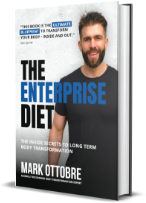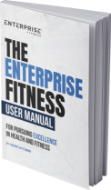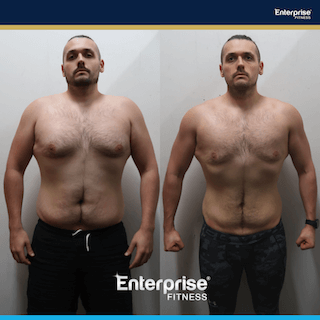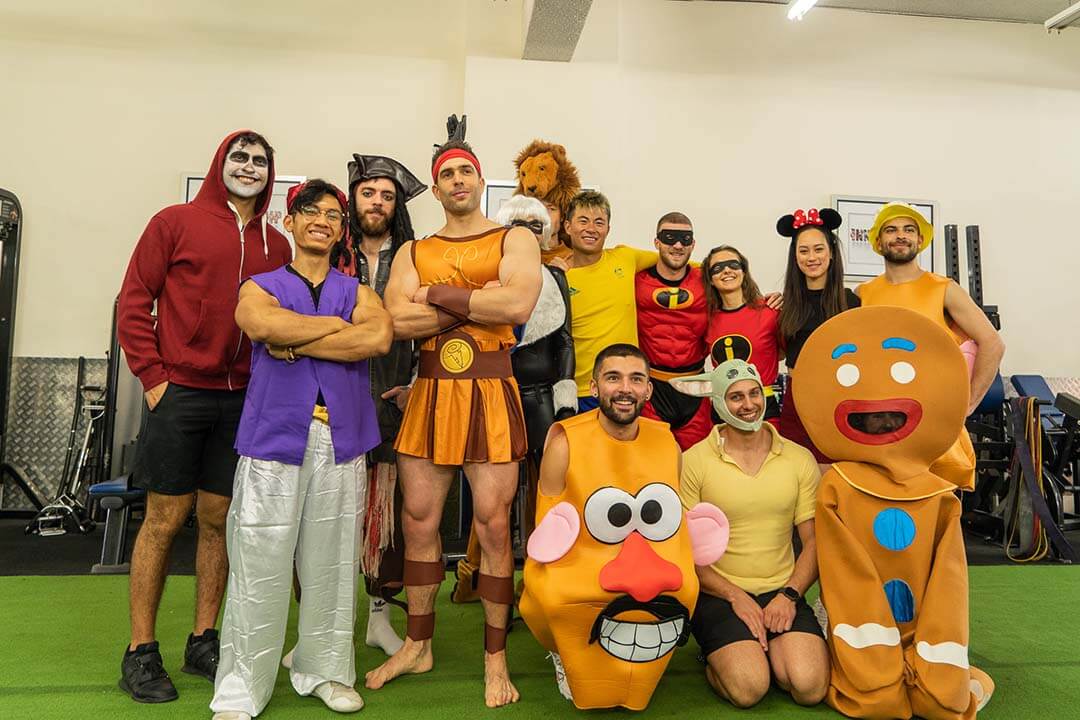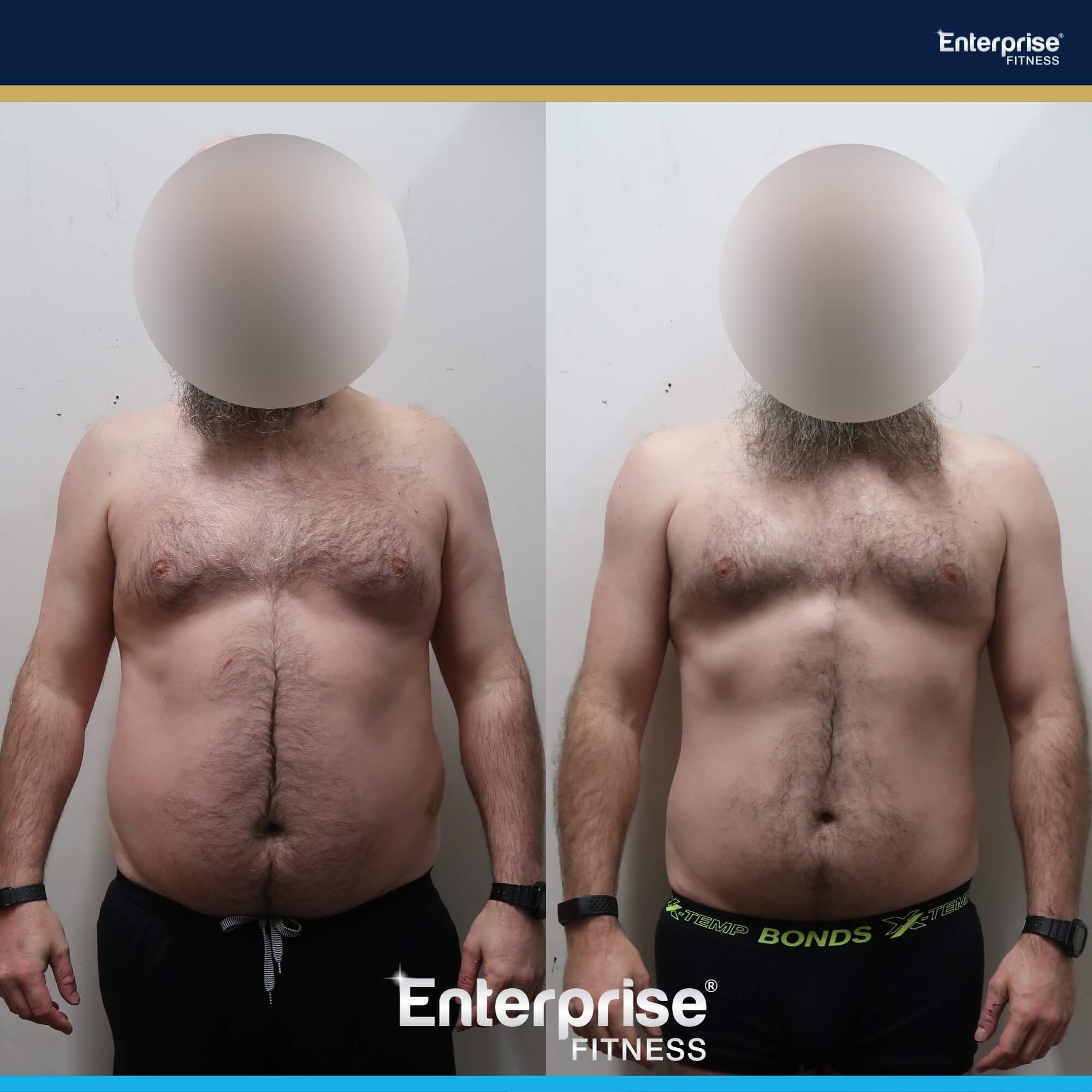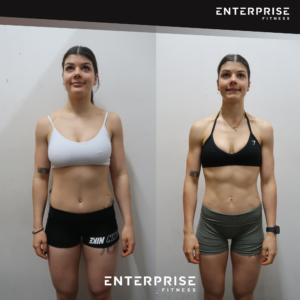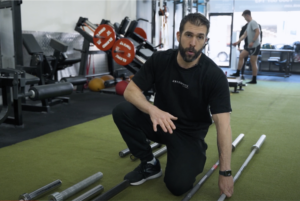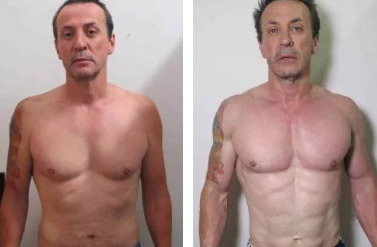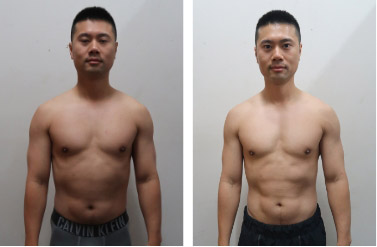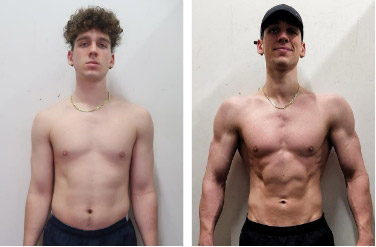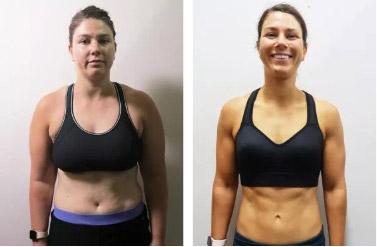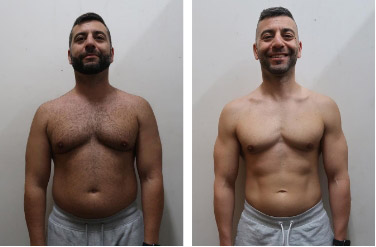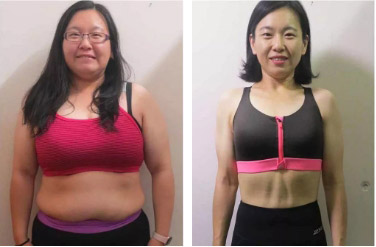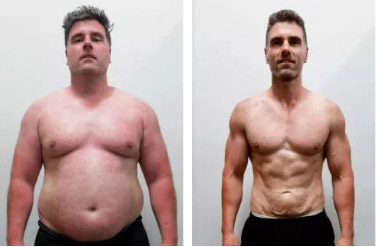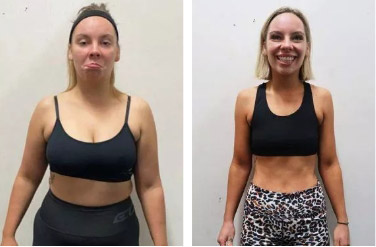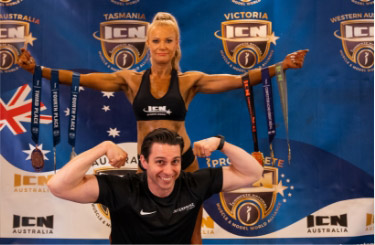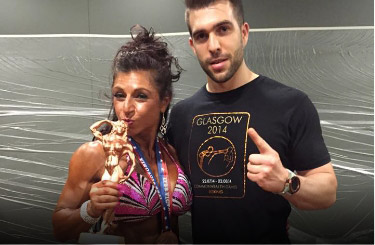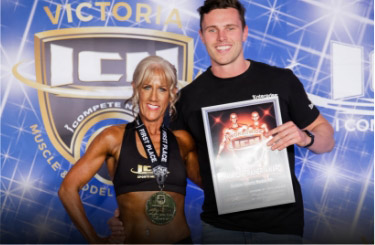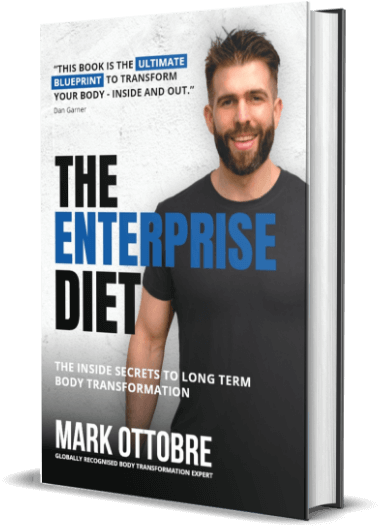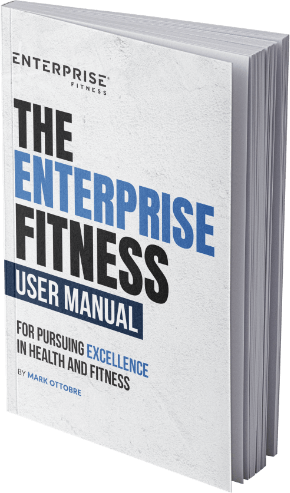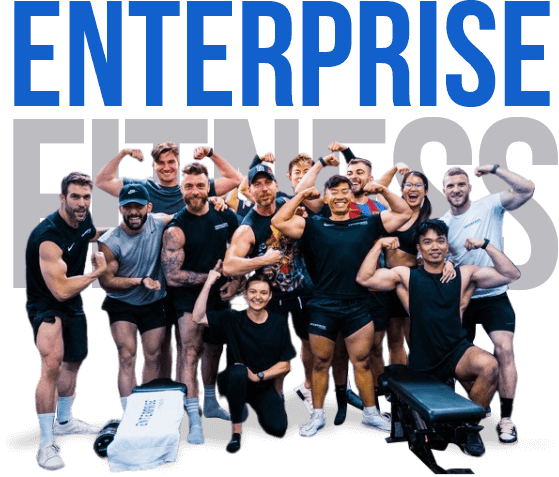We have all heard of the Paleo diet, and today’s guest on the Enterprise Fitness podcast is one of the kings and original thinkers of the whole paleo movement – Dr Art De Vanny.
Learn about:
- Why the post work out window is complete nonsense
- Why you should train hungry
- Intermittent fasting – and why it can help you bust out of a plateau
- The raw food rebuttal
- And Art’s thoughts on how to feed the world using a Paleo diet!
Art graduated from Montebello High School in 1955 and signed to play professional baseball for the Hollywood Stars. He was one of the very few pro baseball players to lift weights, which led scouts to give him the nickname of Superman in their scouting reports.
The name stuck and the Times of London called Art “Superman’s slightly fitter granddad”. Dr. De Vany went on to earn his Ph.D. in Economics at UCLA and to become a respected scientist who is known over the world through his articles and books. He is listed in Who’s Who in America and Who’s Who in the World and is the author of the acclaimed Hollywood Economics.
A lifelong student of metabolism and fitness, Art has lived as a Paleo athlete for some 30 years and is called a patriarch of the Paleo movement. He has blogged on the subject since the 1990s and continues to blog on the subject on his Evolutionary Fitness blog at www.arthurdevany.com. He is the author of The New Evolution Diet which you can purchase from Amazon.
Related Posts
- Heavy Metal 101 – The Enterprise Fitness Podcast
- The Consequences Of A Low Fat Diet – The Enterprise Podcast
- Achieving Victory Over A Toxic World – Enterprise Fitness Podcast
- The Vegetarian Myth – Enterprise Fitness Podcast
The following is a transcription taken from an interview with Dr Art De Vany and Maximus Mark Ottobre on diet, nutrition and evolution.
Due to the nature of transcriptions we cannot guarantee accuracy, spelling or grammar. We think we’re doing pretty well to bring you both audio interviews and transcriptions with world leading authority on health and fitness free of charge. If you’re able to edit transcriptions free of charge, we would love to hear from you.
Mark: This broadcast is proudly brought to you by maximusmark.com and Enterprise Fitness. And of course you can find other great interviews like this at maximusmark.com or by searching itunes maximusmark.
Hey folks, it’s Maximus Mark and welcome to the show that punches you in the face with information but in a good way. It’s Maximus Radio.
I’m super duper psyched for today’s show. It’s what we all call a “cracker” of an episode. We’ve all heard of the Paleo Nutrition Movement, well, today’s guest is one of the kings and original thinkers of the whole Paleo Movement. Today’s guest is Dr. Art de Vany.
Art graduated from Montebello High School in 1955 and signed to play professional baseball for the Hollywood stars. He’s one of the very few pro-baseballs at that time to actually lift weights, and now a universal practice, which led scouts to give him the nickname of “Superman”. Well, that nickname actually stuck and recently the Times of London called Art “Superman’s Slightly Fitter Granddad”. What an awesome nickname.
Dr. Art de Vany went to earn his Ph.D. in Economics at UCLA and has become a very respected scientist who’s known all over the world for his articles and books. He’s listed in the “Who’s Who America” and the “Who’s Who in the World” and is the author of the acclaimed “Hollywood Economics”.
A lifelong student of metabolism and fitness, Art has lived as a paleo-athlete for some 30 years and he’s called “The Patriarch of the Paleo Movement.” He’s blogged on the topic since 1990 and continues to blog on the subject on his “Evolutionary Fitness Blog” at www.arthurdevany.com. He’s the author of “The New Evolution Diet” which you can purchase from Amazon.
It is my absolute pleasure that I welcome today Dr. Art de Vany to the show.
Welcome Art! How are you doing today?
Dr. Art: Hi, it’s going very well Mark and thanks for having me on the show.
Mark: Absolute pleasure to have you on. The first question that we have… it’s kind of the question we always start with… how did you become the patriarch of the Paleo Movement? I mean, you’re an Economics professor through your university life, how did you really get into paleo lifestyle?
Dr. Art: Well, you become a patriarch by merely being old. (laughs)
But actually, I was into health and fitness far before I was an economist. I was into weightlifting by the age of 14, started with a 90-lb weight set in my parents’ garage, and get a little Olympic lifting, and one competitive bodybuilding contest that the owner of my gym pushed me into. Then of course I decided I didn’t like professional… but then I decided to play professional baseball but I didn’t care much for that life. I really was a professor even then.
They called me “Superman” in those days because I was the only guy who lifted weights in professional sports, perhaps, to my knowledge at least… and I had horn-rimmed glasses and look rather like Clark Kent in the old Superman show.
But the thing is, Economics and metabolism are essentially the same thing. They’re both about allocating scarce resources to competing ends. In the case of human metabolism, every cell is an independent agent that’s only cooperating to sustain life to some kind of complex, feedback loops and the dance of life is one that’s completely controlled by these centralized processes with each cell trying to maximize its own nutrients and its own DNA. Somehow, rather that whole complicated process has sustained its life very far from equilibrium. Economics is exactly the study of that kind of process, the centralized allocation processing. Actually my Economics equipped me extremely well to understand.
But the real turn was when my young son, 2-year old son, developed Type 1 diabetes when I was at the University of Chicago for a visit. Type 1 diabetes is of course is an interruption in the insulin’s secretion process from the pancreas… and soon as that happened, I went right down to the University of Chicago library and just bought all the books I could find on metabolism, diabetes, and so forth. I plunged into the study of metabolism out of necessity, many, many years ago.
Mark: Right. So can you set up the frame for the listeners, can you tell me how we actually lived 40,000 years ago? I know that you make more reference to 40,000 years ago as oppose to 10,000 years ago before industrial farming. Just want to set it up and get the scene in the listeners’ minds.
Dr. Art: Well, yes. I don’t know if you notice but humans went through genetic bottleneck about 70,000 years ago. That was when there was this massive eruption… we’re in the depths of an ice age… there was a massive eruption of a volcano in Indonesia… Philippines actually… and the temperatures plunged about 70,000 years ago. From that period until about 40 or 50… or nearly around 30,000 years ago… there was just a handful of humans even alive. It may have been 2,000 to 8,000 humans left. They were living through not only the depths of ice age but through essentially a volcanic winter on top of that.
So, during that time, this is a period of time when modern humans emerged. They actually emerged maybe 70,000 years ago right during that critical period. In 40,000 years ago, we start to see truly complex human thought, it’s left in the art, the symbolism that we see 35-semi thousand years ago… we see the magnificent cave art, that’s still really can’t be topped, and you see jewelry and human decoration, and burials, and social organizations. It’s clear that something happened to allow humans to survive during that almost nuclear winter. It had to be the use of symbolism and cooperation.
In addition to that, the brain developed prodigiously right around that time, beginning about a hundred thousand years ago, but peaking probably about 30,000 years ago. The reason for that is that we were pushed to the seashores by the intense cold and forging along the seashores… and by the way, you see evidence that seafood exploitation about a hundred and eighty-five thousand years ago at the southern tip of Africa and even before that, you see that in the Rift Valley, in Africa where modern humans were born… the prototypes… is the exploitation of freshwater streams and lakes. The Rift Valley’s full of lakes from the folding of the earth, from the fact that India and Africa are colliding and pulling apart in different places making a lot of rifts and deep valleys there.
So we lived on seafood for a very substantial… even crocodiles by the way… for a substantial period of time and that allowed the probably unsaturated fatty acids that are essential to the construction of the modern, very large, metabolically active human brain.
Mark: So I’ve also read other things like different cultures who didn’t have as much saturated fat and didn’t have the resources in their diets just simply weren’t as smart. I remember someone referring seeing something about the Kenyans, they didn’t develop the bow and arrow and some people have correlated it to the saturated fats in their diets. Can you provide any comments on that one?
Dr. Art: Yes. I think they would have had far fewer fatty acids than people living along seashores. But what did happen was there were many migrations in and out of Africa as we know now, and freshwater sources definitely provided probably about half the calories that humans ate 32,000 years ago, in fact they know that from looking on the dentition, the teeth and bones of Cro-Magnon humans who were found. They were higher on the nitrogen chain which means they were eating meat and seafood, even then the wolf. In fact, they were pure, stone cold carnivores, when you include in carnivory the flesh of sea and freshwater fish.
The atlatl, I don’t know where that was created but that was the precursor to the bow and arrow. That was the throwing stick with a sort of dart-like spear that really completely transformed human hunting technology and became the basis for humans killing off many of the Magnon-thron, many of the large animals that couldn’t be fast enough given their size relative to the rate at which humans could kill and eat them.
But anyway, pre-fatty acids book by Crawford & Marsh for example, “The Evolution of Human Nutrition”, I think it’s something to that effect at the title, I cite in my book, they do credit the availability of the polyunsaturated fats, rich in Omega 3 and 6 fats, some others in long chain fatty acids with the evolution of modern human cognitive ability and brain size.
And also cooking coinciding with that. Richard Rhinaman has written this book on the importance of fire, something like fire is in the title. He’s a professor at Harvard and he credits the development of cooking which allows us to trade stomach tissue for brain tissue. So we develop smaller stomachs which is metabolically active tissue equivalent to brain.
So we develop smaller stomachs which are metabolically active tissue equivalent to brain… by the way, it turns out stomach is part of your brain. You probably know that. That’s why when you feel it in your gut, you really do. You got a lot of brain tissue down there in your gut.
Anyway, by making the stomach smaller through the use of cooking, you’re basically using an external environment to pre-process food and so that tissue could be traded for more brain mass up in the cranium. So cooking was a very important feature there in addition to the availability of freshwater and sea foods.
Mark: Let me ask you on that. I had on a couple of months ago Aajonus Vonderplantiz and Josh Trentine, we spoke a lot about raw food. Aajonus particularly has told me that he’s lived out doors for extended periods of time and he’s definitely in the school of thought that raw food is superior and ancestry perspective, we ate more raw meat but then there was that point that we develop fire and we started to cook the meat. So I want to get your thoughts on… number one, what’s your thought on raw meat and number two, what’s your thought on raw vegetables?
Dr. Art: Okay. Well, raw meat is a lot harder to process and I don’t think Rhinaman will agree that eating raw meat would have been a basis for the development of modern humans. Certainly, it was the basis for life among all predators and humans are way up on the predatory chain, from that point of view. But here we are, we live in this modern world and modern world is full of pathogens and food processing. As long as you eat meats that are grown on free range and were properly cared for, if you can tolerate raw meat, why not eat it. But for example, sashimi and other Japanese raw foods, I simply avoid now. I don’t trust the oceans and the handling of food, and modern restaurants where who knows who’s cooking and handling the food, these things. So, I think, we also have to realize that we have drug-resistant toxins and pathogens living today that would not have been able to live in the ancient times and we have to respect the lethality of these toxins. I cook virtually everything… and I never eat hamburger of course, because in hamburger the surface is ground in to the interior of the meat so the pathogen is taken deep into the meat where it can really breed.
Mark: So you mean like minced meat? You never had minced meat or anything like that?
Dr. Art: Minced meat, hamburger… you know whatever… sometimes sausage but I cook it very thoroughly.
So in raw vegetables, I eat a lot of vegetables in my salads but again they’re a little bit difficult to process and utilize so you have to cook it sparingly. It really convinces me that our foods largely are cooked to a significant degree. By the way, the campfire was place where people gathered… there was almost always a campfire available to ancient humans even though you and I go out there and we think we could never build a campfire, but they can build one.
Mark: Yeah. So before I move on from the raw food issue, a lot of people talk about raw food they say there’s a lot more enzymes in raw meats that’s probably one of the most popular arguments with the raw food issue. Do you have any thoughts I guess on the enzymes being available, when you cook the food the enzymes get destroyed. Is that false?
Dr. Art: Yes, but the proteins get broken down ‘cause enzymes are just proteins. So you’re talking about the degradation of proteins when you talk about what cooking does and that makes them more bio-available to a significant degree. I don’t have a problem with cooking. If you do want to eat raw, more power to you. I’m agnostic at this point, I don’t get religious with these kind of things.
Mark: Good answer. Many of my listeners train very hard and straight after training, they’re sucking down protein shakes. As you’ve said before, a religious belief that they have to get the protein straight after training. What’s your thought on protein powders and the whole “we need protein immediately after training”?
Dr. Art: Well, this is all based on that fictitious notion that there’s a window of opportunity of some sort. Now what does that window mean? It means that there is a period of insulin sensitivity following an intense workout. The period of insulin sensitivity is shut down as soon as you start eating carbohydrate laden energy protein drinks. Protein shakes cause insulin to be released, that’s when its sensitivity collapses, carbohydrate causes insulin sensitivity to collapse, they also shut down the production of growth hormone and leptin, both things that mobilize energy to build new tissues and to fuel your movement and make you burn fat. So you basically shut down fat burning in the post exercise period and if you train hard like I do, and probably you do, you’re looking for a… I mean, an intense post-exercise excess respiration period. That’s where you’re breathing more and replenishing your ATP in your cells by consuming extra oxygen during that time. Well, any time you take these protein drinks you close the window. It’s not like the window was open for fixed period of time.
Now let’s consider how much you do absorb. Suppose you take a big bowl of protein and carbohydrate right after training, well the window shuts pretty quickly and so the post-exercise period that you spend all this time and energy trying to create is abbreviated. On the other hand, you just eat… maybe like I do, in an hour after you’ve workout, you’d allow an hour for fat-burning to take place and for leptin and growth hormone to do its role; but you’ve also extended the period of insulin sensitivity, in other words the window stays open longer.
Over the long period of time is really no difference between the amount of protein you absorb, if you consume it right after the workout or you consume it over an extended window of time. But the window’s open for 24 hours if you eat moderately following a workout.
Mark: But what would you eat after a workout?
Dr. Art: I would eat what I normally eat..
I would work out hungry because you don’t want to move unless you’re hungry. Hunger makes you feel like you need to move. When you’re hungry you’re restless, when you’re well-fed, you’re lazy… you sit down, you’re the lazy overeater.
There’s a researcher friend of mine says, and it’s well known in the literature, you cannot make these caged rats or mice exercise unless you keep them hungry. If you feed them too well, they’ll sit on the treadmill and just not move. One guy had a mouse said it would sit there and the fir sort of burn it’s behind because he wouldn’t get up and run while the treadmill’s turning. The fact that, to keep the mice about 18 to 20% below the amount of calories they would ordinarily need in order to keep them in motivation to move.
Mark: That’s a primal trigger isn’t it? Because we have to get up and hunt our food.
Dr. Art: That’s exactly right. Hunger says we better go find some food, our brain and our whole metabolism is geared to. We shift to fat-burning because that’s a long-lasting fuel that we carry tons of in our bodies. We don’t need energy in order to go workout. We got thousands of calories stored in our liver, in our muscles, in the glycogen, in our fat stores, even the amino acids in our muscles can be used to fuel movement if needed. The human body runs on a variety of fuels even though our primary intake sources are carbohydrates, fats and proteins. We can run on lactate, ketone and glucose.
Mark: Absolutely. It is really the work of Dr. Mauro Di Pasquale.
Dr. Art: Yes, yes I know. In fact, he’s doing the window thing too, keeping it longer.
Mark: Yes, exactly. Just reminded me of what you were saying, when Mauro was talking about how you shut it off and he kind of relates it to premature ejaculation with taking the carbohydrates too early, you’re shutting off the window too early, the effectiveness of eating and the insulin sensitivity can be prolonged for much greater period of time. But yes, that’s really interesting.
You just touched briefly before, I’ve heard you say this before in different proadcasts… eating before training alters gene expression negatively as well, is that right?
Dr. Art: It’s very true… not only metabolic genes such as the genes that determine the fate of the fuels inside the body and how the cell uses the nutrients but also your mitochondria which are the primary sources of ATP production within the cells.
Gene expression is maximized, and research shows it pretty clearly, in a restricted carbohydrate setting. When you take carbohydrate, you alter the metabolism and you also alter how you shift from a process which is called autophagy which is self-eating. When you workout when you’re hungry, your cells actually consume the damaged proteins inside your cells and recycle them into fresh new structures. So every workout tears muscle protein right… tears actin and myosin, what’s going to happen to those damaged tissues?
Well, they’re going to be degraded by autophagy, this process of internal consumption of damaged proteins and the get recycled as fresh proteins. So you’re making and laying down new cell tissue, new, healthy cell tissue at a much higher rate if you train empty and hungry. The minute you have any carbohydrate… like you eat these energy bars before you go workout and I see guys doing that all the time, wait a minute, first of all, you’re not going to burn fat now. Secondly, you’re going to completely shut down autophagy because it only operates when insulin is virtually zero… and you’re going to damage proteins inside your cells which is how you make them grow. You damaged a muscle and then it comes back stronger and bigger… and so you shut both processes down. It’s really quite dumb. It sells supplements.
Mark: Yes, definitely. One of the things I want to get before we move on, so the ideal training time would be as soon as you wake up, say you wake up at sunrise and train what, a half hour after that?
Dr. Art: I train just about any time I feel like it because life would have been an adventure in the Paleolithic and we didn’t have routinized activity patterns, they would vary seasonally, they would vary according to the cold and the heat and the migration patterns of animals, and a host of things like whether you’re going to fish that day, or you’re going to try to find some large game, whether you’re following reindeer moving across the globe, you’re following herds migrating.
What I do is I train according to what I call the Power Law which is this notion of fractal of physiology. Humans and all living creatures don’t live in a permanent state of sort of homeostasis where everything is the same all the time.
Variation is in fact, what makes us alive. That’s what our brains are for… is to adapt to variations in the environment that less complex animals are not capable of doing. I have a sort of Power Law training, which means that I work out at random intervals… not completely random, not like flipping a coin but every third day I go a little bit hungry and I work out twice a week, kind of hard in the gym with weights, half an hour and no more… and then I’ll go do sprinting, I’ll play a little tennis, and I’ll just enjoy the outdoors, take walks and whatever. I’ll ride my motorcycle or… you know, whatever.
Mark: All the fun stuff.
Dr. Art: All the fun stuff. It’s supposed to be play. Life’s supposed to be playful and enjoyable.
Mark: Yeah. And the other question I wanted to ask before, just for the listeners, when you say “Don’t have carbs before training” are you also including things like sweet potato with that category as well?
Dr. Art: Well, workout hungry. Whatever you’ve eaten, you should train so hard that you’re on the verge of nausea. If you got food in your stomach you’re just going to puke out earlier.
Mark: Studying both Economics and Nutrition, I’m sure you’ve looked at this question that arises often when adovacting the Paleo lifestyle for the masses, and that question is “We can’t feed the world on a Paleo diet. There just isn’t enough space on the planet.” What’s your thought on that?
Dr. Art: Well, it assumes its conclusion. It’s a preposterous statement, it’s not even a question. It’s just a proposition that’s probably deemed of by some vegan.
First of all, whenever calories’ available to humans per capita is the highest rate it’s ever been in all of human history.
Secondly, virtually all massive starvations occur in agricultural cultures that are highly dependent upon monoculture, single kind of crop or just a couple of crops, and agriculture encourages, even necessitates one or two or three crops whereas our ancestors ate from 300 and more wild plants and multiple animal sources and seafood sources and foods. For example in China, or in India, the dependence primarily on the bulk of calories come from four starchy crops. Now, each one of those is vulnerable to pests, take the Irish potato famine, the starvations in China and the list goes on and on. Suppose you have a loin cloth and a sharp stick and you’re out looking for food or energy, where are the calories? (laughs)
Mark: In the meat!!
Dr. Art: Where are the carbohydrates? There is none! There’s protein and fat and we throw away so much of our fats or we avoid fats almost religiously that we’re wasting a lot of calories that are out there and would have fueled our activities and movement. So it’s really a bogus, it’s not even a question. Now, as far as technology, most starvation is one, as I’ve said, in agricultural societies not in hunt-and-gather societies, but two, technology is easily capable of supplying the foods, in fact, it’s already done so. It’s not the number of calories available in the world today, or even in the future, they move toward more plant or animal-based agriculture, it is the distribution of foods. So the starvations we see are always episodic and highly concentrated on the places where they have really bad government. Right?
Mark: Right.
Dr. Art: China, Soviet Union, Rwanda Ethiopia, and so forth. All the recent starvations are the results of poor distribution of foods, and wars, and really, really bad governments like the Soviets and Chinese collectivization of agriculture. China’s in a difficult time, China has the agricultural revolution there.
Mark: Is it because of trying to globalize the food supply… it should be localized?
Dr. Art: I think we should have both operating very clearly. First of all, if you have secure property rights around the world farmers will take care of themselves you wouldn’t have a problem. And all these pastoralists who fly on their land and get pushed out of areas… or whose crops are seized by like Chavez’s doing in Venezuela now, they seize the crops or in Cuba… No wonder Cuba has so few calories produced per capita, there’s no incentive to do so. No wonder, many countries can’t feed themselves because their collectivized agriculture, look what’s happened in… Mugabe has taken over agriculture and it just collapsed. So most of the starvation we see is not from the sources that whoever thought this question up appointing to.
By the way, more animals are killed by modern agriculture because you create this monoculture and you kill the habitat of all the wild creatures that had lived there when you turn it into a vast wheat field. And guess what comes in behind, it’s the vermin. The vermin had learned to follow humans and exploit the agricultural crops that we grow.
Mark: That’s exactly right. I had Lierre Keith on quite a while back, she wrote “The Vegetarian Myth”, we spoke about this very topic… very, very good… very, very enlightening interview.
Science and modern nutrition have developed sophisticated food intolerance screening tests and few books have emphasized the need to rotate foods, let’s say every 3 to 5 days depending on the author. My understanding of the way we lived 40,000 years ago, we didn’t have the luxury of rotating foods or rotating food groups. How important do you think it is to rotate foods?
Dr. Art: Well, I think food variety is very crucial because every plant has so many nutrients in it, for example, amino acids in particular or magnesium, two very crucial nutrients, and as I’ve said our ancestors had lived on up to 300 various wild plants so they rotated constantly. It is well known that people who have wider variety in their diet tend to have better longevity. I don’t know how well known it is but there are studies to support that point of view.
So, now rotation can be thought of in several ways. You can rotate it over season, like our ancestors surely would have done based on availability of different crops. The Eskimo can’t eat berries except there are certain times of the year otherwise they’re dependent on animal and seafood sources. They rotate but they rotate in sort of the seasonal way.
We tend to think of rotation as sort of changing everyday. We sort of reduced the complicated metric of life to what would have been true back in the ancestral times down to “I’ll do it everyday” kind of mentality, highly routinized, sort of chronic way to think about living.
So as long as you vary your activities and vary your food intake whether you do it… like you mentioned, you might eat chicken for a week because you got a good deal on chicken, and another week you might eat seafood, that’s variation.
If you integrate the variation over a longer period of time rather than just a day, like a year, we all had a fairly… well not all, some people eat nothing but the same thing day after day after day all year long because in the modern society you can do it. In ancestral times, it would have been completely impossible. People eat a twinkie everyday now but in ancestral times the carbohydrate would not have been available.
Mark: That’s true. The only way they would really get those high-refined carbohydrates was when the hunter gather stumbled across a beehive and that wasn’t everyday.
Dr. Art: That’s right, that’s right, absolutely. By the way, ancient humans love honey. They will take great risks to try and capture honey.
Mark: For sure, I can understand why.
What I’ll do is I order a quarter of a cow, or 7 kilos of chicken or 7 kilos of kangaroo and I go through basically one animal at a time until it’s gone and move on to the next animal. Again my thinking, it more closely resembles and mimics a modern caveman so to speak, that’s what we’re talking about.
Dr. Art: I really like that. I don’t quite do it that way but… I’ve been very intrigued to try kangaroo, I have to come over to Australia.
Mark: Yes definitely. It’s really good. The only thing with kangaroo’s you can’t overcook it because it does get very tough. You need to have it bit more on the rare side, it really is a great meat.
Dr. Art: Kind of like venison then, same thing’s with venison if it’s overcooked, it’s tough as leather.
Mark: This question actually is from a friend of mine who wanted me to ask; Once a primal man has developed the tools to bring down a larger game, he would then engage in feasting. The beast had to be eaten and obviously couldn’t be refrigerated, they would all sit around and eat and eat and gorge themselves. It seems like the human body has an inherent capacity for overeating. So the question is do you think it’s not only ok to overeat but on occasions to advantage providing it’s the right food?
Dr. Art: I certainly don’t disagree with that description of the pattern, although in the Northern environment to kill a mammoth, it would have been frozen and you could keep it around for quite a long period of time. Same thing’s true with an animal that freezes in the North, you can exploit the food as you see fit over a fairly long period of time.
Meat and protein were scarce always… always, always, always. There was a lot of sharing, and meat became a commodity for bringing groups together around the fire and sharing and building relationships which were so crucial to survival during the depths of the ice ages. You had to share knowledge and activity and helping one another. Meat sharing I think probably is a big element of what makes us human.
Gorging, of course, we can readily gorge in that’s the idea that you don’t want to let calories go to waste because you’ll never know when you’re going to find another one. So I think that’s definitely a survival advantage. It used to be thought that there was a so-called “Thrifty Gene” that some people could store food more than others, that’s been discarded now and it’s clearly bogus because if you store food far more effectively than someone else that means you don’t use energy, so it means you’re not an energetic person… you’re fat. So how are you going to survive? That really makes no sense.
Mark: That is only one of the theories around people born around the Great Depression.
Dr. Art: Well it’s probably true now in India where we have an explosion of Type 2 diabetes. The people who are developing it were born at low birth weight because their mother was under nutritional stress. So how does the fetus cope with that? It becomes resistant to the action of insulin because the mother’s resistant to insulin too. The fetus and the mother are competing for nutrients… It comes back to economics again.
In later years, when the infant grows up and finally has adequate calories available, that promotes further insulin resistance and leads the pathway to Type 2 diabetes. Indians and Chinese who are susceptible for this… by the way, diabetes among Chinese living here in the United States is enormously high for the same reasons – low birth weight, insulin resistant as infants and insulin resistance is carried forward to later in life when calories are abundant and you eat all these darn rice.
This is “Sarcopenic Obesity”, is what this is called. Skinny fat is what we call it in our website. Their body fat composition is not within the Paleolithic range and the metabolism goes away.
Mark: For sure. Now I answer this question a lot, I want to kind of ask the question so the listeners can get it from you as well, do you think its advantageous to eat 5 to 6 regular meals a day like most fitness magazines promote?
Dr. Art: It’s completely ludicrous. It’s suicide too because you have to be what they call a post prandial state, a period formed after the meal or you’ll never burn fat.
So only way people like this burn fat is when they sleep. That kind of frequency keeps your insulin… (they’ve promoted this idea too)… keep your insulin in the range, in the zone, but it keeps you also chronically elevated so the basal range of insulin released is always relatively high and it never falls to a low. So it’s like having a little loud noise irritating you all the time, you’re metabolism turns off to it. You actually defeat your insulin sensitivity by doing this.
The best thing to do is to have low insulin, one, you won’t age at the same rate. My insulin’s at the bottom of the range the lab can measure my fasting insulin. But when I eat, my insulin jumps up, nutrients go right where they are needed and then insulin goes back to virtually nothing again. So I’m not turning on my aging pathways. The insulin IGF pathway is THE aging pathway. The more you activate it, the more rapidly you age, the less resistant to stress you are, the more damaged proteins, and accumulated toxic fats you have inside your body. Remember, the fats inside your body have a shelf-life and the longer it stays on you, the older your fat cells are the more toxic they are because they become rancid, and they produce free radicals which age you and damage you and damage your DNA and cellular tissue. It’s stupid… unless you have a bad liver or bad kidney.
Mark: What about when people say, and this is a question I get a lot, what about the metabolism, don’t we need to eat 5 meals a day to keep the metabolism burning?
Dr. Art: (laughs). It’ll wake up when you eat, what’s the point? You never switch to fat-burning if you always have food coming down the pipe. You want to be primarily a fat-burner, that’s the safest, staple, densest fuel to burn. When you burn carbohydrate, you damage your mitochondria, it produce lots and lots of free radicals. Therefore damaged by the free radicals you’re producing, the result is they commit cell suicide and the density of your mitochondria over long period of time will decline, and their function will decline. Once your mitochondria start to go away, you are in an energy crisis. So what happens is the body becomes fatter in order to supply more free fatty acids to the mitochondria. So somebody who has low mitochondrial density and function, you can guarantee is going to be fat because that’s the adjustment the body has to make in order to supply extra fuel to the weak mitochondria that it has. So most of the things people talk about are completely backwards.
Mark: And I guess the other mentality… I try to tell as many people as I can, obviously to my clients, listeners… one of the questions I always get asked, is how many times a day should I eat and I always retort with how many times a day do you want to eat? I think that’s really the core that people need to get out of this “I need to be told by someone else how many times a day should I eat.” You really need to start listening to your appetite, listening to your hunger. When you get hunger, that’s going to tell you, “Hey you need to move. Let’s eat something.” not reaching for a bag of chips or something like that. Eating a proper meal is really what it’s about.
Dr. Art: If you eat real food, you get hunger and you exercise in a fun but somewhat intense way, you’re appetite will completely guide you or your energy requirements or what you eat. I eat usually two meals a day, sometimes four, sometimes one, sometimes none. Remember in medieval England, a lot of people in Australia came there from England, the norm was two meals a day. About ten o’clock, they eat something after they’ve gone to the fields and at four o’clock, they get home because dark was coming soon, so two meals a day’s pretty much… three meals a day and more than that is a completely modern notion. It’s only possible in a society like ours where we have food right down the hall anytime you wanted or right across the street or what you have in the refrigerator.
Mark: I actually spoke to, I think her name’s Lyn Oliver and she’s the editor for Food Timeline, and I asked her where the whole concept of three meals a day came from and she actually got back to me and she said the earliest time it was printed “three square meals a day” was 1857 and it was from the British Navy and what they actually used to do is serve three meals a day but they actually served it on square plates so that’s where it kind of came from. Yeah, she said exactly the same thing. It used to be getting not meals, it used to be talked about as getting a bite to eat, or getting something to eat because people just didn’t have the money to sit down and eat three meals a day, just wasn’t possible.
Dr. Art: Absolutely. So that’s where three square meals a day comes from?
Mark: Yeah, interesting. There’s been a lot said about intermitted fasting, it’s a topic I haven’t covered at all in previous shows. What’s your thoughts on intermitted fasting?
Dr. Art: Well, I didn’t invent it but I was one of the very earliest proponents of intermitted fasting. I began intermittent fasting, it’s a fractal or chaotic pattern of eating that coincides with my fractal and chaotic pattern of exercise. By the way you can measure your fractal variation and get an assessment of your health. If your health is not so good your going to find there is very little fractal … you’re heartbeat’s more like a metronome than it beats like a natural living heart which has a wide range of beat intervals and scales that it operates on. You can read a little about fractal physiology in my book, I have a few books on my website about it as well. It takes you back to the notion of fractal dimension, for example, human beings are decentralized, self-organized systems and fractal variation is an essential part of how our metabolism and our physiology is really organized.
Well, I happen to build a very complicated model of the Paleolithic energy, life energy landscape. I found that about a third of a time, our hunter-gatherer ancestors are pretty damn hungry and it was very unpredictable. You kill a large animal, you feast for a few days and then you go out and hope you find something, you might go a week without anything but a few berries and a few slugs. That’s how I came into it and then I heard the talk of the calorie-restriction society where I gave a talk and have been a guest myself. A doctor from Stanford have actually tested intermittent fasting and you can eat the same number of calories… let’s say, in a 2-day period, eating every other day or splitting the calories and eating each day, guess who will have the better metabolism and the better body composition?
Mark: The one who fasts.
Dr. Art: The random eater, the one who eats intermittently. It has a profound effect on metabolism and our body composition. Every experiment that has been done on intermittent fasting… by the way, intermittent fasting doesn’t mean that you restrict the amount of calories you eat, it means you vary the intake over, let’s say, in a week or every other day or every third day. My pattern is typically, I under eat every third day. But I don’t under eat, in any real sense of the word, I probably average 4,000 calories a day. But again, it’s not a chronic day after day after day. Your metabolism just can’t handle that. You’re far more healthy and have better body composition if you kick that same pattern and break it into 5,000 in one day, 2,000 in another day, 3,000 in another and so forth. Your appetite, as I’ve said it, once your metabolism has adjusted and you come in to a sort of healthy fractal variation and the way you live your life, and work, and play, and eat, you have no problem. I weighed 200 lbs for about 60 years and I have no clue how many calories I really eat. I just calculated the other day where my BMR was and do a little math on it that I have never done before. A lot of people have waited the same weight for 30 or 40 years but they have no muscles left are fat and they still weigh the same. I have the same body composition that I’ve had since 17 or 18.
Mark: For sure. Another question that you probably get asked a lot obviously this is taking into account when you fast or when you’re on intermittent fasting, do you meat everyday, do you eat meat when you’re obviously not intermittent fasting and isn’t that dangerous?
Dr. Art: Not at all dangerous. Modern meats are not up to the quality of the meats we had or the variety, so I eat a wide range of meats. The only time meat can be a problem for somebody is if they have damaged kidneys. Their kidneys are damaged not from eating meat but from free radical damaged typically from a lifetime of bad diet. They deplete the glutathione in their kidneys, in their liver, the metabolism goes away, they drink a lot of fructose in their softdrinks so they damage their kidneys and their livers. Only people with compromised liver function are at any risk at all of harm from eating meats. The fats not a problem so far as you balance the fats that are in there with… I trim most of my meat, I don’t eat really fatty meats… but that’s just sort of my preference. There’s really no evidence that it’s particularly a problem. Look at it this way, the first study that was done on this was still the one that always cited the danger of excess protein consumption. First of all, they weren’t taking in the proper pro factors and nutrients, the protein was in the context of fat, more like a dose of pure protein. Secondly, they drew their conclusion base on the fact that the kidneys have adjusted and become larger, like they were becoming too big in some way; but that actually turned out the way the kidney adapts when you eat a high protein diet, it’s perfectly healthy adaptation.
Mark: We’ve got time for one more question, I’ll shift you to a Facebook question, this one, George asked, I kind of know the answer to this one already but I’ll ask it anyway, Paleo diets say we should all avoid grains because they are poisonous but surely these plants were available to our ancestors and they would have eaten them in small quantities. Do we really need to eliminate them completely?
Dr. Art: Well you don’t need to do anything you don’t want to do. Your health consequences will be better if you do eliminate grains because remember grains and the seeds of plants are not mobile so they have pesticides in them, the lectins and other toxins. Most of the most lethal poisons come from plants, in snakes of course, like ricin made from… that’s the favorite Soviet KGB poison for knocking off spies, it comes from the castor bean. There’s a great deal of lectins… lectin is a class of protein that includes gliadin and glutens but there are many others and lectins are quite toxic.
Here’s the point, I don’t really try to mimic with any kind of authenticity what our ancestors ate, there’s some evidence that seeds were eaten or even roasted maybe 30,000 years ago but it would have been the last choice. It would have been a poverty food during very difficult times otherwise the calories as we’ve concluded are in the animals. So that’s the take if you proceed on the basis of evolutionary biology and evolutionary metabolism then you have a more sophisticated view of what you’re trying to do. You’re trying to take in nutrients that are healthful and sort of reduce the load of toxins and the things that alter gene expression… and certainly lectins alter gene expression. For example, the locust that preys upon the tamaraus tree, it doesn’t grow flight muscles if it ingests the seeds of the tamaraus tree. The tamaraus tree has developed a toxin that interferes with gene expression so the flight muscles never develop. It’s evolutionary warfare.
Mark: So you just touched on then that you don’t mimic the exact diet, would you include any supplements in your regime or is that out of the question too?
Dr. Art: I do because let’s face it, our foods these days are far less nutritious than they would have been in ancient times. For example, there’s a preference for less tasty fruits and vegetables, minerals of course make vegetables kind of bitter and not as pleasant to the modern taste than maybe they should be. Well it turns out that most of our foods and our water supply were depleted of magnesium and the rise of depression around the world is almost surely connected to the depletion of magnesium in the modern diet. It’s also true that the antioxidants, phytonutrients and so forth are less dense now in modern foods. So I do take supplements, I make sure to take magnesium… in fact I’ve just developed my own supplement in conjunction with Dr. Dimopolous who holds the patent of oral glutathione that is absorbable.
Mark: How much magnesium will you take a day?
Dr. Art: Well it depends on how depleted you are. Most people are quite depleted. Vitamin D and magnesium deficiencies are very common now. They have Vitamin D test, they also have magnesium test. I take… of course I eat Brazil nuts, I eat a lot of nuts and they are rich in magnesium, I eat a lot of green plant foods that are rich in magnesium. I supplement with 800 millgrams.
Mark: 8oo milligrams, that’s what the great, late Robert Crayhon recommended as well.
Dr. Art: Oh good. That and Vitamin D… of course I get a lot of sun, here in Utah we have a very intense sun, I’m sure you do in Australia too. But still on days when it’s cloudy, I don’t get outside much I might take 5,000 IU’s of Vitamin D. I haven’t been sick in 30 years, let’s just put it that way. It really works.
Mark: So where could people go to learn more about you?
Dr. Art: Well, the easiest place is my website but they can also Google me. I’m all over google in my various careers as an economist and fitness guru and so forth. But my website is probably the most reliable because it comes from me and it’s www.arthurdevany.com
Mark: I know you’ve got photos up there of you working out, articles about training, heaps and heaps of different stuffs. Can you get the book “The New Evolution Diet” from that website or do you have to go straight to Amazon?
Dr. Art: I have link to my Amazon, or Barnes and Noble or couple of other book sellers. In fact, you can buy a cheaper on Amazon or Barnes and Noble that I can buy from my publisher. (laughs)
Mark: What does the future hold? What are you working on at the moment?
Dr. Art: Well, interesting you’ve asked. I work very intensely with Dr. Dimopolous on this supplement. I’m very intrigued in taking this evolutionary perspective deeper into the sense of the gene expression and the whole notion of the genome and the biome… and so getting into genomics and pathways that alter the aging process itself. Of course, insulin’s IGF pathway has been identified and I talk a lot about it on the book but I’m trying to work a little bit more on that. I’ve form a company that tried to exploit my book; Hollywood Economics as well, that is certain things, ideas I’ve developed there, try to patent it as a financial Instrument for hedging risks in motion pictures.
Mark: What final thoughts do you have or final things to I guess to sum it up?
Dr. Art: I just think people ought to relax a little bit more, not keeping too wrapped up in advice from so many different sources. All science involving living things must rely at some point to evolutionary processes and gene expression. By the way, a very hopeful message that comes out from my perspective and the perspective that maybe others might have as well is that you’re not stuck with your genes. You can alter the way they express themselves. You can completely transform yourself. I’ll just go to a picture of Otto and Ewald that I put up on my website many years ago, back in the 90’s. Two German twins, one’s a runner, one’s a weightlifter, identical twins otherwise you cannot imagine two people more different than these two do. Same genes, different bodies, simply because of the way they live, what they do and how they alter their gene expression. So this is all called epigenomics, it’s altering gene expression through things that you do and eat and how you handle your stress.
Mark: Absolutely. Well that’s a really good message and I think a lot of people need to hear that living in this day and age thinking what they’ve got is what they’ve got and they can’t do anything about it. We need to inspire some health and fitness into everyone and most importantly… Get the education out there so they can change. I always say with things like motivation, motivation just makes people do dumb things faster, it really needs to get back to education.
Dr. Art: That was a lot of fun. I enjoyed this interview very much.
Mark: I really enjoyed speaking to you as well. Thank you so much for coming on.
Dr. Art: It’s been fun. Your readers are lucky to have you, you’ve got a lot of sharp things to say. Thanks.
Mark: Thank you very much and have a great day, looking forward to seeing new books in the future.
Dr. Art: Ok. Thanks Mark.
Mark: Thanks. Bye.
Hey folks it’s Maximus Mark. What do you think of that interview with Dr. Art Devany. That was a cracker-jack of an interview. So obviously, there’s a lot more interviews that you can download at www.maximusmark.com/radio or just simply by searching iTunes and searching for Maximus Mark, and if you are on iTunes, please do leave a comment and give a review. I would really, really, really appreciate it. You can download other shows that we’ve done. We’ve done shows with Johnny Bowden, Randy Roach talking about the history of nutrition and bodybuilding, Mark Schauss talking about toxins. Aajonus Vonderplantiz on raw foods, Lierre Keith on the vegetarian myth, Michael McEvoy talking about functional nutrition. We’ve even got a business interview on there with Travis Bell talking about personal training. We’ve done sweet poison with David Gillespie, The Gluten Show with Dr. Thomas O’Bryan, The Mindset of a Champion with two-time Miss Olympian Janet Kane, The Unintended Consequences of a Low Fat Diet with Allan Watson, The Primal Blueprint Show with Brad Kearns, The Raw Food Show with Joshua Trentine, and the three-time Miss Olympia, Marie Saviane.
All those interviews are available completely free and you can download them today at www.maximusmark.com/radio
Christmas is nearing, there’s going to be a lot of different issues that’s going to come up from people. If you have any questions, shoot a question to [email protected] and we’ll see if we can get an answer for you. If you guys want to book a session with me one-on-one just email [email protected] and she will hook you up.
Hope you guys are enjoying the show. We have Sally Fallon coming up. She is the president the Weston Price Organization. I’m going to be speaking to her very soon. I’m looking forward to that because I’ve been a massive, huge Weston Price fan since I got started with health and nutrition.
So to wrap up, train hard, supplement smart and eat well,
Maximus Mark
